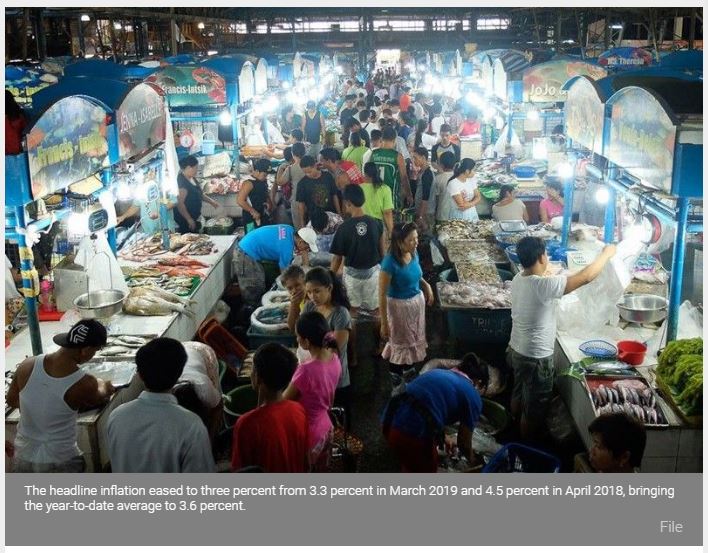Philippines: Inflation slows to 3% in April
MANILA, Philippines — The increase in consumer prices slowed further in April, hitting its lowest level in 16 months primarily due to the falling cost of food, housing and utilities, the Philippine Statistics Authority (PSA) reported yesterday.
The headline inflation eased to three percent from 3.3 percent in March 2019 and 4.5 percent in April 2018, bringing the year-to-date average to 3.6 percent.
The April inflation figure was slightly below the median market forecast of 3.1 percent and is well within the Bangko Sentral ng Pilipinas (BSP) forecast of 2.7 percent to 3.5 percent for the period.
This marks the sixth month headline inflation has decelerated since peaking at 6.7 percent in September and October last year.
The lower inflation was attributed largely to the slower growth in the heavily weighted indexes of food and non-alcoholic beverages at three percent in April from 3.4 percent in March; as well as housing, water, electricity, gas and other fuels which fell to 3.2 percent in April from 3.4 percent in March.
These indexes made up 38.34 percent and 23.5 percent of the headline rate, respectively, and comprise the bulk of household consumption nationwide.
Deputy National Statistician Josie Perez, currently officer-in- charge of the PSA, said slower growth in the prices of several food items such as rice, corn, cereals, meat, fish, oils and fats, as well as sugar and confectioneries were registered in April.
Growth in the rice index fell to 0.02 percent in April from 1.4 percent in March. Perez noted that prices captured during the period still reflected the availability of cheap rice distributed by the National Food Authority (NFA) and still does not take into consideration the effect of the newly-enacted Rice Liberalization Act.
Significantly slower growth was also seen in the index for alcoholic beverages and tobacco at 9.9 percent in April; clothing and footwear, 2.4 percent; healthcare, 3.7 percent; household furnishing and maintenance, 3.2 percent; and restaurant and miscellaneous goods and services, 3.5 percent.
Upticks, meanwhile, were seen in the indices of transportation and communication, growth in which jumped to 3.8 percent in April from 3.3 percent in March, and 0.4 percent in April from 0.3 percent in March, respectively.
Perez said growth in the transport index reflected mostly the increase in ferry prices in April, the start of summer vacation and the month of the Holy Week break during which more people travel to the provinces.
The series of increases in pump prices, she said, also contributed but only at a minimal rate as the increases were gradual.
Headline inflation in the National Capital Region (NCR) fell to 3.1 percent in April from 3.2 in March mainly because of flat growth in the prices of food and education.
In areas outside NCR, growth in consumer prices likewise slowed to three percent in April from 3.4 percent in March as growth in the prices of most commodity groups slowed down.
Across regions, the highest inflation rate was seen in MIMAROPA region in April at 4.6 percent, slower than 4.8 percent in March. The lowest, meanwhile, was seen in Central Visayas at 1.3 percent, slower than 2.2 percent in March.
Socioeconomic Planning Secretary Ernesto Pernia said despite the sustained slowdown in inflation, the government is still monitoring inflationary risks such as the prevailing El Niño phenomenon, possible increase in utility rates, and volatility in international oil prices.
“Given unstable global oil prices, the government should prioritize rolling out the second tranche of its social mitigating measures under the TRAIN law, such as the unconditional cash transfer and Pantawid Pasada, especially now that the 2019 national budget has already been signed into law,” he said.
Source: https://www.philstar.com/business/2019/05/08/1915880/inflation-slows-3-april#eQdFULYYFC0PgubV.99


 Thailand
Thailand




